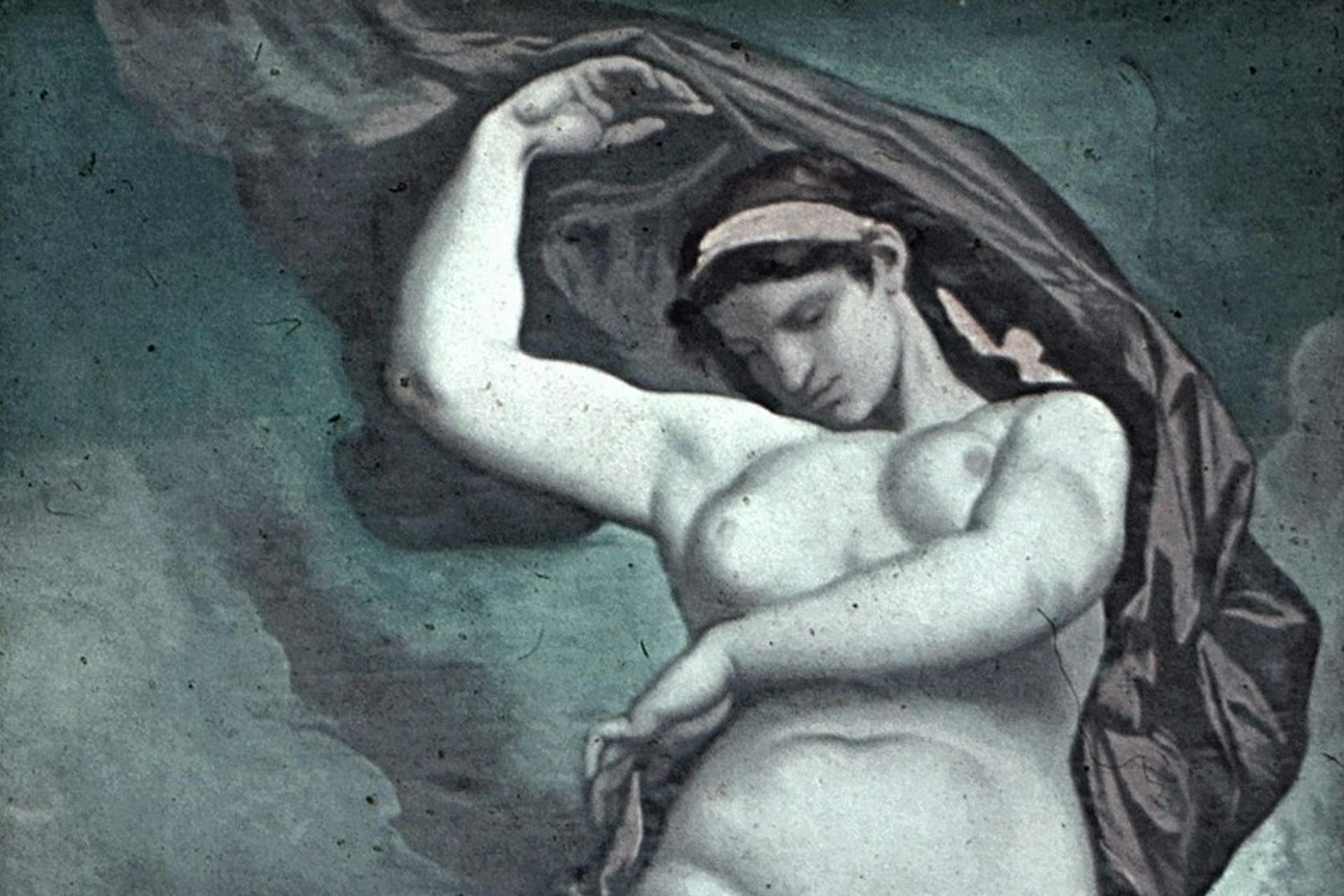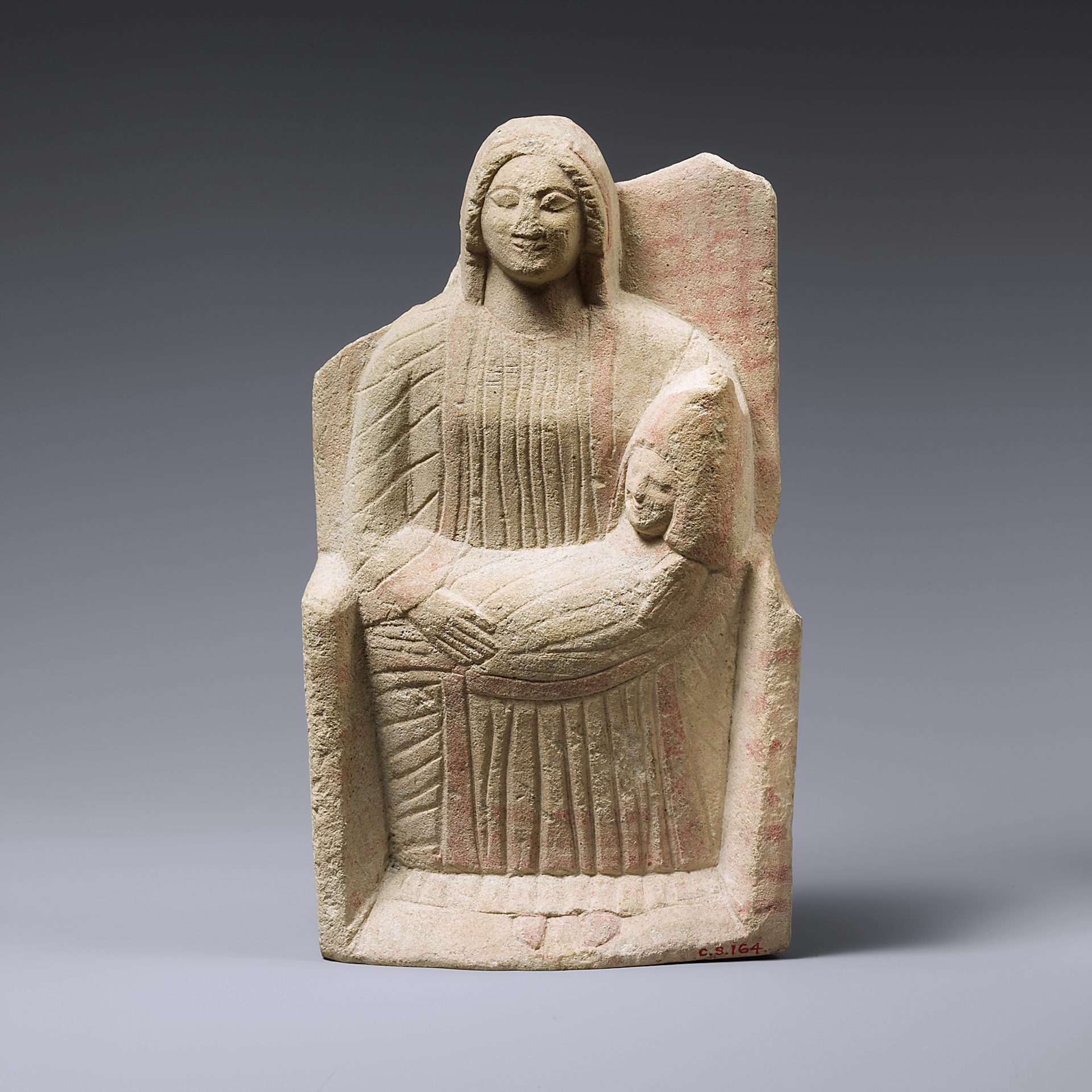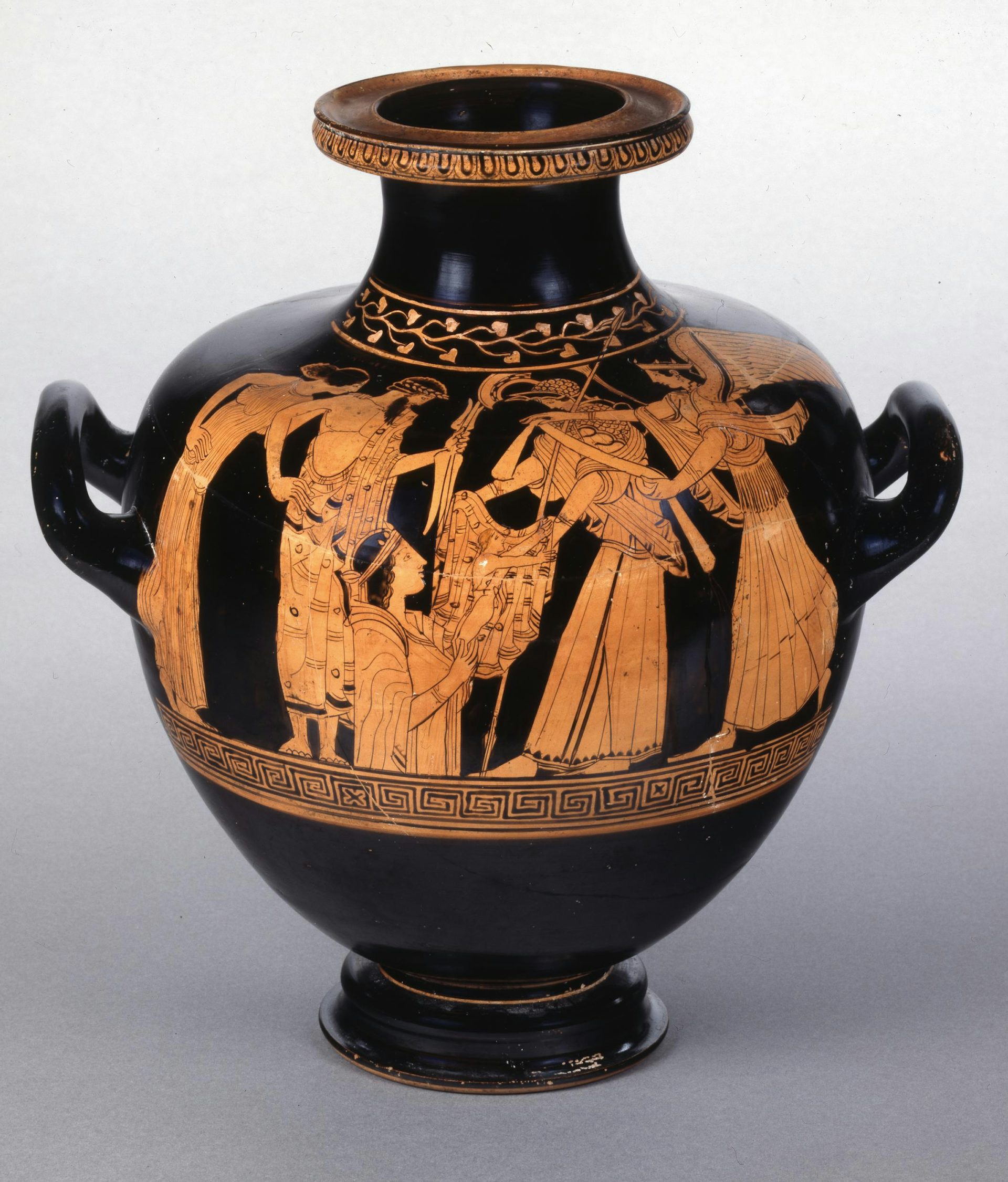Gaia

Overview
The first deity in all of Greek mythology, Gaia was the personification of the earth and the universal mother. With her offspring Uranus, who symbolized the heavens, Gaia molded the universe to her liking. The progenitor of most of the Greek deities, Gaia gave birth to the Titans, the Cyclopes, and the monstrous beings known as the Hecatoncheires. Through the prolific Titans, who each had many children, Gaia became the grandmother of countless mythical figures (including the Olympians).
Gaia’s role in Greek mythology is sometimes contradictory or surprising. She helped her son Cronus overthrow his father, Uranus, but later ushered in another new era in the history of the gods by nurturing the young Zeus and helping him dethrone Cronus. In many of her myths, Gaia also became an opponent of Zeus and attempted to overthrow him on several occasions.
In ancient Greece, Gaia was worshipped alongside Demeter, the goddess of agriculture, as part of a fertility cult. Even today, neopagan religious groups, such as Wicca, observe Gaia as the ultimate mother goddess and giver of life.
Etymology
The name “Gaia” is also the ancient Greek word meaning “earth,” “land,” or “soil,” though the etymology of this word is uncertain. Today, it is usually thought that gaia and gē (a related word, also meaning “earth”) are non-Indo-European and pre-Greek in origin.[1]
Pronunciation
English
Greek
Gaia Γαῖα Phonetic
IPA
[GEY-uh] /ˈgeɪ ə/
Epithets and Other Names
Gaia’s epithets included anēsidōra (“gift-giving”), kalligeneia (“fair-born”), kourotrophos (“nurturer of the young”), eurysternos (“broad-bosomed”), and pandōros (“all-gifted”).
The Roman name for Gaia was Tellus (the Latin word for “earth”).
Attributes
As one of the first deities of creation, as well as its first mother, Gaia was the source of all life. She oversaw the fertility of crops and safeguarded children and fledgling life of all kinds. The Greeks generally thought of her as a chthonic deity—that is, one of the gods associated with the earth and the underground world.

A 5th century BCE "kourotrophos" ("nursing mother") from Cyprus. Figurines like these celebrated fertility and are predecessors to Roman Catholic depictions of the Madonna and child.
Metropolitan Museum of ArtPublic DomainGaia was not often depicted in ancient art, but when she did appear, her connection with the earth was strongly emphasized. She is sometimes shown as a motherly woman from the torso up, while the rest of her body is the earth itself. In other representations, she is shown reclining on the earth, sometimes surrounded by other figures symbolizing the earth and its bounty.
Family
One of the first beings of creation, Gaia did not have any parents herself.[2] She simply came into existence.
Family Tree
Mythology
Origins
In the most common tradition, recounted in Hesiod’s Theogony, Gaia did not have parents but was among the mysterious deities born at the moment of creation:
In truth at first Chaos came to be, but next wide-bosomed Earth, the ever-sure foundation of all the deathless ones who hold the peaks of snowy Olympus, and dim Tartarus in the depth of the wide-pathed Earth, and Eros (Love), fairest among the deathless gods, who unnerves the limbs and overcomes the mind and wise counsels of all gods and all men within them.[7]
Shortly after coming into existence, Gaia created her male counterpart, Uranus, who covered her and assisted her in making the world full. It was Gaia who gave birth to the sea (Pontus), the mountains (the Ourea), and the first beings to inhabit the world she created and embodied.
With Uranus, Gaia sired many children, including the first generation of Titans. However, Uranus was cruel and jealous. Suspecting that his own children would usurp him and take his place as ruler of the heavens, Uranus banished them to the grim Underworld realm of Tartarus as soon as they were born.
Unwilling to see her children’s lives so carelessly wasted, Gaia fashioned a sickle from grey flint and counseled her sons and daughters to rise up against Uranus and castrate him with the blade. Hesiod imagined her pleas to her children as follows: “My children, gotten of a sinful father, if you will obey me, we should punish the vile outrage of your father; for he first thought of doing shameful things.”[8]
Cronus was the only one of the Titans who obeyed his mother’s bidding. Taking up the cruel, curved weapon, he severed his father’s genitals and threw them into the sea. As he did so, multitudes sprang forth from them, including giants, nymphs, and the beautiful Aphrodite.[9]
In time, Cronus morphed into a tyrant. Like his father before him, he became paranoid that the children he had sired with his sister Rhea would rise up and overthrow him. To prevent this from happening, Cronus ate his first five children—Demeter, Hera, Hestia, Hades, and Poseidon—as soon as they came into the world. But Rhea managed to secret her final child, Zeus, to a secluded cave, where he was raised by his grandmother, Gaia. The mother goddess taught the future king of the gods well, and he eventually went on to destroy his father and inaugurate the cosmological order as the Greeks knew it.
Gaia and the Olympians
It was not long before Gaia turned against Zeus as well, just as she had turned against Cronus and Uranus before him. Gaia gave birth to Typhoeus, an enormous and terrifying monster, and sent him to confront Zeus. After a difficult battle, Zeus was finally victorious.
Undeterred, Gaia next sent the Giants to battle Zeus and the Olympians.[10] The Giants were Gaia’s children by either Uranus[11] or Tartarus.[12] They were fantastically strong and arrogant and were often represented with serpentine features, such as scaly feet, snakes for legs, or snake hair.[13]
The war between the Olympians and the Giants was called the Gigantomachy. In antiquity, it was sometimes confused or conflated with the Titanomachy, which was fought between the Olympians and the Titans. There are few ancient sources that describe the war in any detail, but according to the best-known traditions, the gods learned of a prophecy that stated that the Giants could only be defeated with the aid of a mortal.[14] The Olympians thus recruited Heracles, the greatest of all mortal heroes, to fight with them.
In the end, the Giants were destroyed, thus foiling Gaia’s plots against the Olympians yet again.
Other Myths
Gaia also played a small role in a handful of other myths.
Gaia was sometimes said to have been the mother of Orion, a Giant and a great hunter. In most versions, Orion was killed by Artemis after he offended her somehow. There were other versions, however, in which he was killed by Gaia herself: fearing that the insatiable Orion would hunt down and kill all the animals on earth, she sent a giant scorpion to slay him.[15]
Another of Gaia’s children, the Giant Antaeus, battled against the mighty Heracles. As a son of Gaia, the earth mother herself, Antaeus was invincible as long as he was touching the earth. When Heracles realized this, he was finally able to defeat his opponent by hoisting him up off the ground and breaking his back while suspended in midair. Without the nourishment of his mother, Gaia, Antaeus was killed.
Gaia was also involved in the mythology of Aristaeus, an agricultural god closely associated with beekeeping. Aristaeus was usually said to be a son of Apollo and the nymph Cyrene, though in some traditions his parents were Gaia and Uranus.[16] According to Pindar, it was Gaia who nursed the infant Aristaeus and made him immortal.[17]
In numerous myths, Gaia found herself accidentally pregnant after some god spilled his seed on the earth. Thus, Gaia was sometimes said to have been the mother of the Erinyes, Meliae, and Giants, who were born from the blood that fell upon the earth when Cronus castrated Uranus.
Possibly the most famous example of this type of myth is Ericthonius, one of the founding kings of Athens. In this story, the smith god Hephaestus fell in love with the virgin goddess Athena and tried to rape her. The details vary across the different versions, but in each of them Athena was easily able to escape, and Hephaestus ended up ejaculating on the earth. Gaia then became pregnant and bore Erichthonius, who was taken under Athena’s wing and eventually became king of Athens. Because of this, the Athenian people always claimed to be “autochthonous”—that is, originating from the very earth that they inhabited.

Vase painting showing Gaia rising from under the earth to deliver the infant Erichthonius to Athena (ca. 450 BCE).
The Trustees of the British MuseumCC BY-NC-SA 4.0Worship
Gaia was one of the chief chthonic gods of the Greeks. Chthonic gods were closely associated with the earth, agriculture, and the Underworld. In ritual, their most distinctive quality was that the animals sacrificed to them had to be black.
Despite her role as one of the first beings and a creator of the cosmos, Gaia was relatively minor in ancient worship and cult. However, there were a handful of rituals associated with her. Gaia was often called upon to safeguard oaths, in poetry as well as in day-to-day life.[18] In Athens, the mythical king Erichthonius (himself a son of Gaia) was said to have decreed that Gaia Kourotrophos (“Gaia Nurturer of the Young”) must receive a pre-sacrifice prior to any other sacrifice.[19] Gaia was also invoked as Ge Karpophoros (“Earth Bearer of Fruit”) during severe droughts.[20]
Finally, Gaia was associated with oracles and prophecy. The vapors or fumes that produced prophetic inspiration came from the bowels of the earth, and thus from Gaia. The most famous of all Greek oracles, the oracle of Apollo at Delphi, was said to have originally belonged to Gaia.[21]
Gaia had temples, sanctuaries, and altars throughout the Greek world, including at Athens,[22] Sparta,[23] Olympia,[24] Tegea,[25] and Aegae.[26] In some places, such as the city of Patrae in central Greece,[27] Gaia was worshipped alongside Demeter, the goddess of agriculture and thus another earth mother.
There were also said to have been numerous cult statues of Gaia, some of them extremely ancient. Unfortunately, none of these has survived, and we know little about what they would have looked like.
In Rome, Gaia was worshipped as Tellus. There was a temple of Tellus built around 304 BCE near an important road in Rome.[28] The festival of Tellus, called the Fordicidia or Hordicidia, was held every April and involved the sacrifice of cattle.
Pop Culture
In modern times, Gaia has thrived in neopagan religions such as Wicca, where she is worshipped as Mother Earth.
The Greek goddess was resurrected in the naturalist work of James Lovelock. In Gaia: A New Look at Life on Earth (1979), Lovelock argues that organic and inorganic matter on Earth interact symbiotically in ways that create ideal conditions for the perpetuation of life. For example, the profusion of photosynthesizing plants has helped to regulate the temperature of the Earth over its history, creating stability and allowing the evolution of more diverse forms of life. Many followers believe that Lovelock’s use of Gaia represents a union of science and spirituality.
Gaia has also appeared in the Percy Jackson and the Olympians book series by Rick Riordan. In line with some of her actions in ancient mythology, Gaia here serves as a recurring antagonist, inciting war and impelling the titular hero on his journeys.